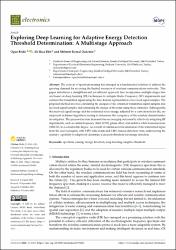Exploring deep learning for adaptive energy detection threshold determination: A multistage approach

Göster/
Erişim
info:eu-repo/semantics/openAccessAttribution 3.0 United Stateshttp://creativecommons.org/licenses/by/3.0/us/Tarih
2023Üst veri
Tüm öğe kaydını gösterÖzet
The concept of spectrum sensing has emerged as a fundamental solution to address the
growing demand for accessing the limited resources of wireless communications networks. This
paper introduces a straightforward yet efficient approach that incorporates multiple stages that
are based on deep learning (DL) techniques to mitigate Radio Frequency (RF) impairments and
estimate the transmitted signal using the time domain representation of received signal samples. The
proposed method involves calculating the energies of the estimated transmitted signal samples and
received signal samples and estimating the energy of the noise using these estimates. Subsequently,
the received signal energy and the estimated noise energy, adjusted by a correction factor (k), are
employed in binary hypothesis testing to determine the occupancy of the wireless channel under
investigation. The proposed system demonstrates encouraging outcomes by effectively mitigating RF
impairments, such as carrier frequency offset (CFO), phase offset, and additive white Gaussian noise
(AWGN), to a considerable degree. As a result, it enables accurate estimation of the transmitted signal
from the received signal, with 3.85% false alarm and 3.06% missed detection rates, underscoring the
system’s capability to adaptively determine a decision threshold for energy detection.
Kaynak
ElektronicsCilt
12Sayı
19Koleksiyonlar
Aşağıdaki lisans dosyası bu öğe ile ilişkilidir:


















